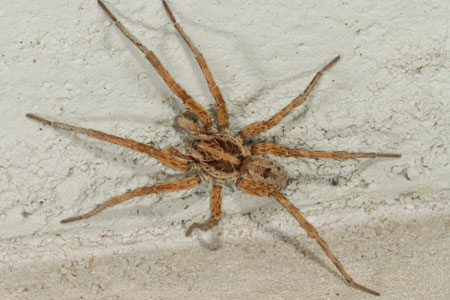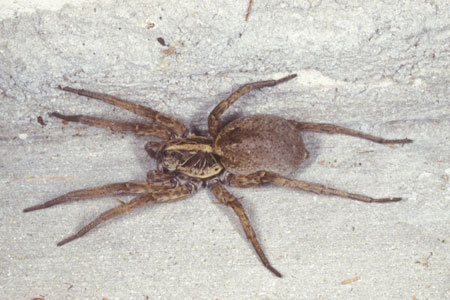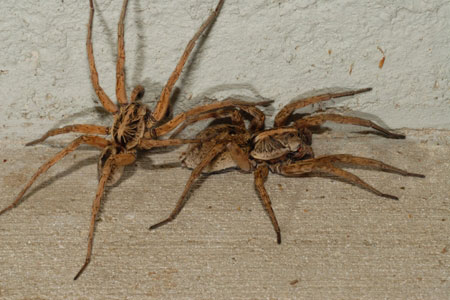Active Seasons




Wolf Spider Appearance and Size Facts
Wolf spiders, named for their wolf-like hunting abilities, are characterized by their large size and hairy bodies. They are unique from other spiders and don’t typically spin webs to catch prey. An extremely common spider, you’ll find wolf spiders in Florida and across the U.S. and beyond. Some features of wolf spiders include:
- Typically brown, tan, gray, or black
- Often have line or scroll-like patterns on their bodies
- Can range from one-quarter of an inch to 1.5 inches
- Have two eyes larger than the others
Identifying Wolf Spiders from Other Spiders
Wolf spiders can often look similar to jumping spiders but are usually larger, as a jumping spider is typically smaller than three-quarters of an inch and can be as tiny as one-eighth of an inch. While wolf spiders can jump, they typically can’t jump as high and don’t jump as often as their jumping spider brethren.
At first glance, many homeowners can mistake the wolf spider for the dangerous brown recluse. While both of these spiders can be brown, the brown recluse is characterized by its unique violin-shaped body and much smaller size, typically the size of a penny, while a wolf spider can be much bigger – if you’re unsure, however, getting help from a spider control expert can help you avoid a potential run-in with a brown recluse.
We provide spider control for wolf spiders in the following locations and their surrounding areas:

Behavior and Habitat of Wolf Spiders
Wolf spiders can often live in or around homes for years without you even noticing. They often avoid human contact and are nocturnal, preying on smaller insects at night. If you spot a wolf spider in action, its agile running may catch your attention.
You may be wondering: Are wolf spiders dangerous? Despite their large size and imposing presence, wolf spiders are mostly harmless. They typically only bite humans if provoked or touched and can also act as natural pest control, feeding on ants, flies, and other small bugs. That said, they are still unsettling to see around your home.

Signs of Infestation of Wolf Spiders
Think you may have wolf spiders? The most common sign of wolf spiders in your home is simply seeing one. Since these spiders don’t spin webs, they don’t make much of a mess in your home or leave many signs of their presence. You’re more likely to find them in dark, quiet places or at night.
Wolf spiders typically come into your home searching for their food of choice: other bugs. If you see lots of wolf spiders around your property, you may consider if some other smaller pest is attracting the wolf spiders.

Tips for Prevention of Wolf Spiders
There are some general steps you can take to prevent wolf spiders, like keeping your home clutter-free and sealing all gaps around the outside of your house. Keeping any plants or shrubs around the sides of your house well-trimmed can also help prevent wolf spider entry. The best part? These steps can also help you keep out other small pests that serve as food sources for wolf spiders, cutting down on the reasons for these predatory spiders to enter your home.
Getting Rid of Wolf Spiders
Luckily, wolf spiders typically pose little threat to you or your home. Unlike pests like roaches, rodents, or flies, wolf spiders typically don’t spread disease or cause too much of a bother. Regardless, you may not want to see these big arachnids skittering around.
To prevent wolf spiders from entering your home, be sure to get rid of any other pest infestations that may be drawing them to your home. Clean and dust your home regularly, particularly those hidden corners where wolf spiders could hide.
If you encounter a wolf spider, don’t squish it. These spiders typically carry their eggs on their bodies, so squishing them can cause their egg sac to burst and release several baby spiders. If you come across one wolf spider, we recommend leaving it alone or carefully catching it and releasing it outside. If you’re dealing with several wolf spiders, or just don’t want to risk an encounter with similar-looking dangerous spiders, call Hulett for expert help.
Effective Wolf Spider Control Solutions
If you keep seeing wolf spiders around your house, it’s time for a free pest control inspection from Hulett to discover what bugs are attracting these large arachnids. We’ll help you knock out any current infestations and get a plan in place to keep them out!
Our expert pest control technicians can also take care of your wolf spider infestation or any other bugs they may find with tried and tested methods developed from Hulett’s 50+ years of experience providing Florida pest control. Whatever pests find their way inside, just call Hulett for the finest home pest control solutions!



